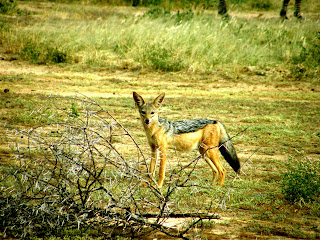


Red horn-bird is a unique bird specie which is found at the Ruaha national park.
The trees produce white flowers just before the onset of the rains, the resultant fruits are rich in cream of tartar and are eaten by people and animals. They are also a rich source of honey. Boababs are surrounded by legends and superstition such as the well-known tale that God planted them upside down. Other trees of note in the park include winter thorn (faidherbia albida) which is easily recognized in the dry season as it gets its leaves when most other trees have none, and vice versa. It therefore provides important shade along the great Ruaha river and other areas. It has a distinctive seed pod which gives it its other common name of apple-ring acacia. Tamarind trees (Tamarindus Indica) are evergreen with a pale grey bark and provide shade year round along the river banks. The fruits van be used for many purposes including making chutney, jams and a tangy refreshing drink.



Elephants are at the park feeding on vegetation.
Elephants (Lexodonta Africana) are found throughout the park. In the 1970s there was great concern that the .large numbers of elephants were destroying the trees and altering their habitats. In 1980s poaching was widespread and the numbers of elephants greatly reduced. Their numbers are now stabilized around 12,000 in the whole Ruaha eco-system. They may even be increasing as the threat of poaching has been eliminated and family groups with many young calves are often seen. Visitors will notice that some elephants have no tasks.

A male giraffe is taller than the female
Ruaha is the only park to have both greater and lesser kudu known scientifically as ‘Tragelaphus Strepsiceros) are tall elegant antelopes normally seen in small family groups of between five and ten, the males have impressive spiraled horns. Lesser kudu (Trageluphus imberbis) are smaller shyer animals found usually in pairs and in more densely wooded areas. They are also more distinctly striped. Roan antelope (Hippotragus) are often seen in the rift valley section of the park. These large antelopes are pale rufous colored with both male and female having horns that curve backwards. They are normally seen in herds of about twenty in more open habitat.


Wild dogs are of different types as you can see these ones with stripes on their back are types of species which can be found in Ruaha National park.
Sable antelope (Hippotragus niger) inhabit the more wooded miombo lands part of the park. The males are easily recognized by their black colour and long horns, females are reed-brown and sometimes confused with roan although they have larger horns and are darker. Wild dogs (Lycaon pictus) are quite frequently seen by visitors. Normally they live in groups of between six and 16 individuals, although groups of over 30 are often seen. Packs can cover large distances. The park is one of the few places in Tanzania where wild dogs are still numerous.











No comments:
Post a Comment